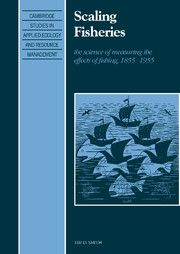Book contents
- Front Matter
- Contents
- Acknowledgements
- Preface to the Paperback Edition
- References
- Units used in the text
- Part I INTRODUCTION
- Part II DEVELOPING METHODS, 1855–1940
- 2 Research approaches, 1855–1890
- 3 Measuring the effect of fishing, 1890–1900
- 4 The International Council for the Exploration of the Sea, 1900–1920
- 5 Predicting fluctuations, 1920–1930
- 6 A priori methods, 1930–1940
- Part III THREE PARTIAL THEORIES, 1940–1955
- Notes
- References
- Index of people
- Subject index
3 - Measuring the effect of fishing, 1890–1900
Published online by Cambridge University Press: 22 September 2009
- Front Matter
- Contents
- Acknowledgements
- Preface to the Paperback Edition
- References
- Units used in the text
- Part I INTRODUCTION
- Part II DEVELOPING METHODS, 1855–1940
- 2 Research approaches, 1855–1890
- 3 Measuring the effect of fishing, 1890–1900
- 4 The International Council for the Exploration of the Sea, 1900–1920
- 5 Predicting fluctuations, 1920–1930
- 6 A priori methods, 1930–1940
- Part III THREE PARTIAL THEORIES, 1940–1955
- Notes
- References
- Index of people
- Subject index
Summary
We now come to the difficult and so far very obscure question, 'what causes the irregularities in the … fisheries … which have been observed from time immemorial?'. … [T]his phenomena, like everything else in nature, must have its natural causes, which can be found … only … from a scientific point of view.
Georg Ossian Sars 1874Sars' early opinion, that the question of the fluctuations in the catches was solvable but that it had to be approached from a scientific point of view, had been firmly adopted by 1890. The research programs that had been established in the preceding two decades in Russia, Norway, the United States, Scotland, Germany, England, the Netherlands, and Denmark were making rapid progress in developing the basic scientific methods needed, but were making much slower progress in developing answers to Sars' ‘obscure question’ on the causes of the ‘irregularities’ in the catches.
In the 1890s fishermen had two main complaints, as Cunningham, the biologist at the Marine Biological Association (MBA) in Plymouth, outlined (Cunningham 1895a p. 54): ‘the capture of immature or undersized flat-fish, and the decrease in the supply of the more valuable kinds of these fish.’ The fishermen's argument was that the former caused the latter, and hence, that suitable regulations on the catching of small fish would remedy the problems of the fisheries. The fishermen's first concern, the effects of the capture of small or immature fish, was often referred to as the ‘small plaice problem.’
- Type
- Chapter
- Information
- Scaling FisheriesThe Science of Measuring the Effects of Fishing, 1855–1955, pp. 70 - 109Publisher: Cambridge University PressPrint publication year: 1994

